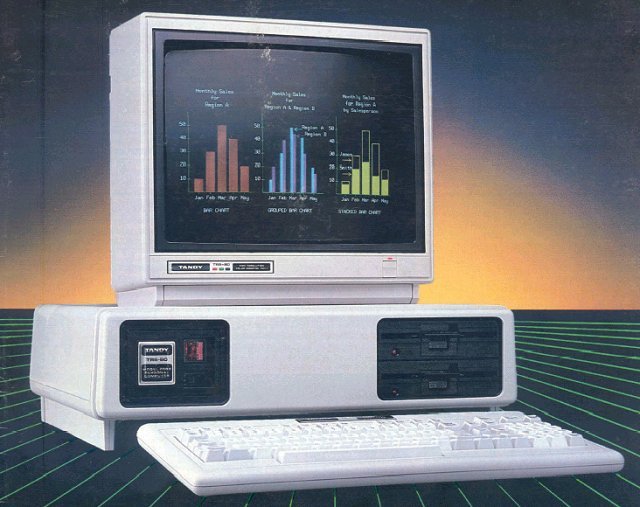
We're so RETRO it hurts the eyes
The Tandy 2000
"Ultra Performance DOS System"

First appearing in the 1984 TRS-80 Computer Catalog (RSC-11), the Tandy TRS-80 Model 2000 was Tandy/Radio Shack's first PC compatible. However, the computer was actually released in 1983, with an introductory price of $2,750 for a dual floppy drive model, and $4,250 for a 10MB hard drive model. The Model 2000 was set to the IBM compatible PC market by storm. Or was it? This new foray into the PC world by Tandy started off a little... weird. The 2000 offered a faster CPU, more disk storage, easier expasion (arguably), and better graphics. Add to that a large library of software already on the market, and Tandy thought they had a winner.

The basic system shipped in the following configuration: two 720k 5 1/4" floppy drives, display adapter, printer adapter, 128k RAM, RS-232 port, and MS-DOS 2.0. It could all be yours for $2,750. By comparison, an IBM PC, similarly equiped (though with smaller drives and less RAM) was $3,658. Tandy opted to go with the not quite main stream Intel 80186 CPU, running at 8MHz. The display capabilities were impressive, 640 x 400 in color or monochrome. Another option was to buy the machine with a single 720k floppy drive, and a 10MB hard drive, all for the bargin price of $4,250.

Tandy was fairly proud of the Model 2000, and they had reason to be. After all, it was more powerful than any of the IBM hardware available when the 2000 launched, and it was better equiped for home and office use than the IBM PC. So what's the problem? It wasn't fully compatible with the PC software or hardware
on the market at the time. The 80186 CPU was a true 16 bit processor - address and data path. The 80186 had additional on-chip features that didn't exist on other 'x86 family members, which were mapped to differing I/O space, making a true compatible from an 80186 nearly impossible. Further, the printer and serial and ports were proprietary, requiring adapters to interface with popular devices. As far as the BIOS was concenred, it was compatible with the PC/XT and behaved well with MS-DOS. However, the software available tended to work directly with the hardware, bypassing the BIOS and operating system in order to
acvhieve a high level of performance - this left the software incompatible with the Tandy 2000 hardware.
At the same time, the Tandy could implement more memory than the 640k on true PC hardware, and the 640 x 400 graphics (just shy of VGA) was incredible for the time. As far as DOS was concerned, the MS-DOS was a special version that would run only on the Tandy 2000. Standard versions of MS-DOS and PC-DOS would not run on the machine. This did not concern Microsoft as they expected different versions for differing architectures. Radio Shack's last release of DOS for the Tandy 2000 was 2.11.03.
The TRS-80 Model 2000 was the end of the line for the TRS-80 branded machines, coming just as the computer industry as a whole was embracing the MS-DOS standard brought in with the first IBM PC. The sales of the 2000 were not spectacular, fairing quite poorly in the market. What it did do was lay the foundation for the wildly successful Tandy 1000 line.